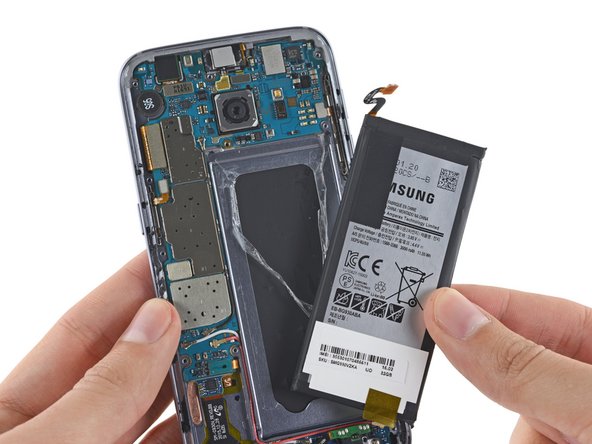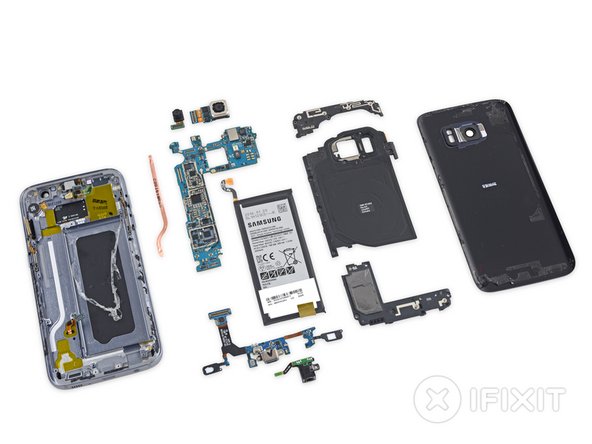
- While legend has it that the number 7 has magical qualities, there's no knowing what qualities the S7 has. If we were to guess completely at random:
- 5.1-inch Super AMOLED display with 2560 × 1440 resolution (576 ppi)
- Qualcomm Snapdragon 820 processor with 4 GB RAM + Adreno 530 GPU
- 12-megapixel rear camera with dual pixel autofocus, 4K video capture; 5-megapixel selfie camera
- 32 or 64 GB internal storage, expandable via MicroSD card (up to 200 GB additional)
- IP68 water resistance rating
- Android 6.0 Marshmallow
- Since the S7 has never been seen on the internet before, there's no way to know if these educated guesses are right.
Step 2
- Compared with its predecessor, the Galaxy S6, the all-new S7 is... uhhhh...
- Sorry—which one's the S7 again? We have to flip them over to double-check.
- That's better. Unlike its predecessor, the S7's back panel curves gently on the sides, making it a more grabbable handset.
- The S7 also shaves off roughly a millimeter from the S6's length and width, while packing on nearly a full extra mm in thickness. That said, at 7.9 mm, it's plenty thin—and even sports a reduced camera bump.
- After tearing down the S6, we weren't exactly wowed by its glass-on-glue construction; it scored a 4 out of 10 and a big "meh" in the repairability department. Here's hoping that, appearances notwithstanding, the S7 will fare better...
- Interestingly, Samsung chose to stay with a run-of-the-mill micro USB port, instead of the new USB Type-C standard.
- Many new flagship phones (Nexus 6P, LG G5, OnePlus 2) feature Type-C, though few fully utilize the power of the connector.
- For now, Samsung seems to think that the older, more widely compatible standard is good enough.
- Or, they just thought it would be awkward if all those free Gear VR headsets weren't compatible with the phones they shipped with.
- Samsung has also made upgrading to a new phone incredibly easy, with an included USB adapter. It's almost like they expect you to buy a new phone before your current device is completely worn out beyond repair. Weird.
- With no exterior screws to be found, there can only be one form of dark matter holding this Galaxy together. Yep, that'd be glue.
- Fortunately, it's nothing a hot iOpener can't handle.
- We love any excuse to break out our trusty twin-suction-cupped iSclack tool, and the S7's front and rear glass panels make it a perfect target.
- With the rear glass lifted by a smidge, we attack with an opening pick and slice apart the adhesive.
- Where last year we found gooey white adhesive, we now find gooey black adhesive. Possibly it was reformulated for waterproofing purposes—or, it could just be a matter of better color-matching.
- Removing the back cover hasn't given us access to anything useful—just a smooth surface for the glass to stick to.
- Fortunately, part of that surface consists of screws.
- Actually, that smooth surface contains some useful bits, like the S7's antennas...
- ...and its speaker...
- ...and MY axe.
- We'd rather see a user-replaceable battery, or at least an accessible connector for one, but these days we're not expecting much from Samsung. Its once-lofty repairability scores have fallen hard from the heady days of the Galaxy S4.
- We line up the pieces for a closer look at the individual components, including the wireless charging coil.
- Last year's Galaxy flagship had a singlemidframe with a handful of aggressively adhered parts, so this separation is a welcome change in our book.
- All these modular components connect to the motherboard by way of tiny spring contacts, making removal and replacement a snap—once you've muscled your way past all the glue and glass, anyway.
- Samsung got some flak from consumers for reducing battery capacity in last year's S6. It seems they took the hint and made up for it by including this 3000 mAh battery in the S7.
- That's a significant boost over the Galaxy S6's 2550 mAh battery, and it even beats the much larger iPhone 6s Plus's 2750 mAh powerplant.
- Sadly, as evidenced by this important warning label, the S7's battery does not work in the presence of puppies.
- Although the battery upgrade means more time to binge on apps and games, the battery itself is well wedged and adhered in place, making extraction a little tough.
- If it wasn't designed to be readily removed, then it wasn't intended to be repaired or replaced. Boo.
- Working our way to the motherboard, we pluck out a 5-megapixel front-facing camera.
- Unfortunately, you'll have to work almost as hard to get flawless selfies on the S7 as you did on the S6. The only front-facing camera upgrade here is the shiny new ƒ/1.7 aperture.
- With the front camera out of the way, we lift up the motherboard and find a familiar daughterboard connector on its underside.
- Compared to the 16-megapixel rear camera on the S6, it seems the S7 got a downgrade with a 12-megapixel/4K rear camera .
- However, the sensor in the S7 sports Dual Pixel autofocus technology (a.k.a. phase detection) for every pixel.
- Additionally, these pixels measure in at 1.4 µm—a full 25% increase from last year's model—which will reduce noise and improve overall image quality.
- So, despite having fewer pixels, even photos taken in the worst lighting should come out clearer in a head-to-head comparison.
- Our friends at Chipworks may have beaten us to the punch, but that doesn't stop us from giving this board our due diligence. Squirreled away under the EMI shields, we find:
- SK Hynix H9KNNNCTUMU-BRNMH 4 GB LPDDR4 SDRAM layered over the Qualcomm MSM8996 Snapdragon 820
- Samsung KLUBG4G1CE 32 GB MLC Universal Flash Storage 2.0
- Qualcomm WCD9335 Audio Codec
- And some more:
- Avago AFEM-9040 Multiband Multimode Module
- Murata FAJ15 Front End Module
- Qorvo QM78064 High Band RF Fusion Module
- Qorvo QM63001A Diversity Receive Module
- DSP DBMD4 Audio/Voice Processor
- And on the flip side...
- Murata KM5D18098 Wi-Fi Module
- NXP 67T05 NFC Controller
- IDT P9221 Wireless Power Reciever (likely an iteration of IDT P9220)
- STMicroelectronics LSM6DS3 always-on 6-Axis IMU
- Qualcomm PM8996 PMIC
- Qualcomm QFE3100 Envelope Tracker
-
- Next up is the S7's modular headphone jack.
- Complete with cute rubber seal!
- Looks like Samsung decided to take its ruggedized "Sport" standards to their flagship, with a hefty IP68 rating (the highest level being IP69).
- Perhaps responding to a certain fruit company's recent waterproofing efforts?
- We find more rubber seals around the lower microphone and speaker making for some serious ingress protection.
- Just like its predecessor, the cables for the S7's soft buttons are wrapped around the display-backing frame.
- These sandwiched cables make a daughterboard replacement (including the charging port) next to impossible, since freeing these cables means removing the OLED screen.
- Undaunted, we bring back our iOpener to ease the
tensionadhesive. - While we're at it, we grab a trusty opening pick and set to work on the terrible task of prying open the OLED.
- Peeling up those pesky soft button LED cables lets us finally free the daughterboard.
- Just for those of you keeping score, this messy situation prevents easy replacement of: display and digitizer (of course), USB port, microphone, and soft button LEDs.
- If you need to replace the charging port, unless you have some microsoldering skills, you have two options: sacrifice those soft button LEDs or replace your display in the process.
- Remember that fake "midframe" made of antennas? Turns out the S7 just buried its midframe deeper, and adhered the display to it, rather than secure its display assembly to a midframe with screws.
- This beefs up the S7’s waterproofiness, but means more of a fight to repair the thing should you suffer non-water related troubles.
- Alright, the moment we've all been waiting for: the legendary "liquid cooling" system in the S7.
- It's a tiny copper twig.
- Actually, it's a teeny heat pipe (thin copper tube) with less than half a gram of material, measuring less than half a millimeter thick.
- This may not be as revolutionary as Samsung describes it, but most heat pipes do technically use liquid to transfer heat.
- In the case of the S7, we're guessing that the pipe transfers heat to the phone's metal midframe, where it can then radiate out to the side—or directly into your hands.
- We've seen heat pipes in phones before, but the growing need for them shows how phone processors are getting faster (and sometimes hotter) each year.
- Samsung Galaxy S7 Repairability Score: 3 out of 10 (10 is easiest to repair).
- Many components are modular and can be replaced independently.
- Unlike the S6 Edge, the battery can be removed without first ousting the motherboard—but tough adhesive and a glued-on rear panel make replacement more difficult than necessary.
- The display needs to be removed (and likely destroyed) if you want to replace the USB port.
- Front and back glass make for double the crackability, and strong adhesive on the rear glass makes it very difficult to gain entry into the device.
- Replacing the glass without destroying the display is probably impossible.




![Image 3/3: Or, they just thought it would be awkward if all those [http://arstechnica.com/gaming/2016/02/samsung-galaxy-s7-pre-orders-come-with-free-gear-vr-headset/|free|new_window=true] Gear VR headsets weren't compatible with the phones they shipped with.](https://d3nevzfk7ii3be.cloudfront.net/igi/2ZvrOPWALyPoQT5P.medium)
![Image 1/3: Fortunately, it's nothing a hot [https://www.ifixit.com/Store/Tools/iOpener/IF145-198-5|iOpener|new_window=true] can't handle.](https://d3nevzfk7ii3be.cloudfront.net/igi/wPRHyYuBxeZnVStM.medium)
![Image 2/3: We love any excuse to break out our trusty twin-suction-cupped [https://www.ifixit.com/Store/Parts/iSclack/IF145-243-1|iSclack|new_window=true] tool, and the S7's front and rear glass panels make it a perfect target.](https://d3nevzfk7ii3be.cloudfront.net/igi/jkBQQNqL15ULCXr6.medium)




![Image 2/3: ...[https://33.media.tumblr.com/2e727c5f4e50b0a841180b1c2b5bf830/tumblr_inline_o04r25YEnl1sflqjn_500.gif|and MY axe|new_window=true].](https://d3nevzfk7ii3be.cloudfront.net/igi/NrSDZsmqJLfXCv4c.medium)
![Image 3/3: We'd rather see a user-replaceable battery, or at least an accessible connector for one, but these days we're not expecting much from Samsung. Its once-lofty repairability scores have [https://www.ifixit.com/smartphone-repairability|fallen hard|new_window=true] from the heady days of the Galaxy S4.](https://d3nevzfk7ii3be.cloudfront.net/igi/h2veMSZna3hPUf55.medium)
![Image 1/2: Last year's Galaxy flagship had a single [https://www.ifixit.com/Teardown/Samsung+Galaxy+S6+Teardown/39174#s89600|midframe|new_window=true] with a handful of aggressively adhered parts, so this separation is a welcome change in our book.](https://d3nevzfk7ii3be.cloudfront.net/igi/kAGC2vXxH3XOCMFo.medium)

![Image 1/3: That's a significant boost over the Galaxy S6's 2550 mAh battery, and it even beats the much larger [https://www.ifixit.com/Teardown/iPhone+6s+Plus+Teardown/48171#s107895|iPhone 6s Plus|new_window=true]'s 2750 mAh powerplant.](https://d3nevzfk7ii3be.cloudfront.net/igi/i5xQPCYQXMMcqIbr.medium)



![Image 2/2: With the front camera out of the way, we lift up the motherboard and find a [https://www.ifixit.com/Teardown/Samsung+Galaxy+S6+Teardown/39174#s89614|new_window=true|familiar daughterboard connector] on its underside.](https://d3nevzfk7ii3be.cloudfront.net/igi/qt1WiD6TYTalePXE.medium)
![Image 1/3: However, the sensor in the S7 sports Dual Pixel autofocus technology (a.k.a. [https://en.wikipedia.org/wiki/Autofocus#Phase_detection|phase detection|new_window=true]) for every pixel.](https://d3nevzfk7ii3be.cloudfront.net/igi/hYnkoQM6eBZLYuMm.medium)


![Image 1/1: SK Hynix [https://www.skhynix.com/static/filedata/fileDownload.do?seq=280|H9KNNNCTUMU-BRNMH|new_window=true] 4 GB LPDDR4 SDRAM layered over the Qualcomm [https://www.qualcomm.com/products/snapdragon/processors/820|MSM8996|new_window=true] Snapdragon 820](https://d3nevzfk7ii3be.cloudfront.net/igi/sDLixOkdfEdeAk1j.medium)




![Image 3/3: Perhaps responding to a certain fruit company's recent [https://ifixit.org/blog/7408/iphone-waterproof/|new_window=true|waterproofing efforts]?](https://d3nevzfk7ii3be.cloudfront.net/igi/GkyvsS2TQF12KSik.medium)






![Image 2/3: Actually, it's a ''teeny'' [https://en.wikipedia.org/wiki/Heat_pipe|heat pipe|new_window=true] (thin copper tube) with less than half a gram of material, measuring less than half a millimeter thick.](https://d3nevzfk7ii3be.cloudfront.net/igi/NuXhv1a2fAwLpLmb.medium)
![Image 3/3: This may not be as revolutionary [https://youtu.be/O6KeASdz2AI?t=25m42s|as Samsung describes it|new_window=true], but most heat pipes ''do'' technically use liquid to transfer heat.](https://d3nevzfk7ii3be.cloudfront.net/igi/CD6DUUkBQPZgToEX.medium)




